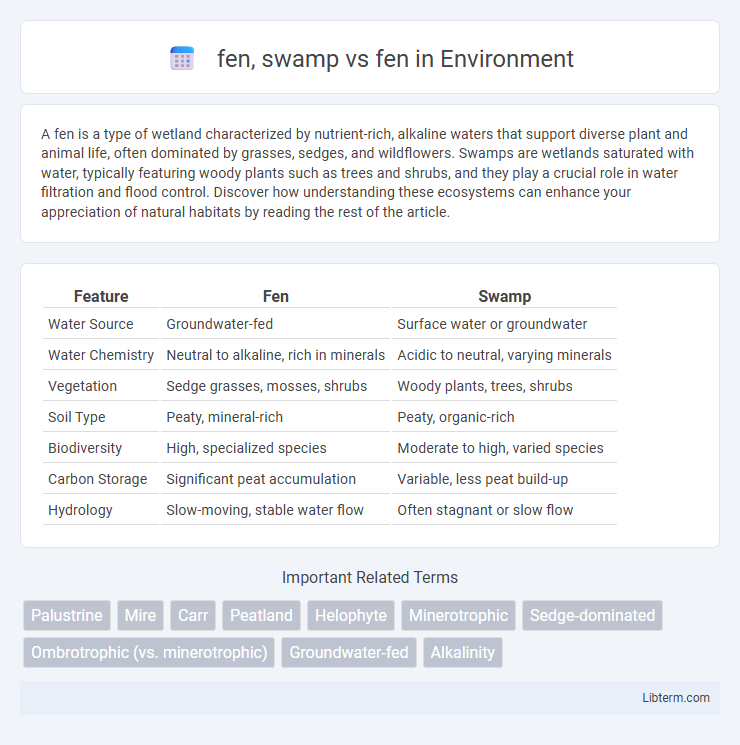A fen is a type of wetland characterized by nutrient-rich, alkaline waters that support diverse plant and animal life, often dominated by grasses, sedges, and wildflowers. Swamps are wetlands saturated with water, typically featuring woody plants such as trees and shrubs, and they play a crucial role in water filtration and flood control. Discover how understanding these ecosystems can enhance your appreciation of natural habitats by reading the rest of the article.
Table of Comparison
| Feature | Fen | Swamp |
|---|---|---|
| Water Source | Groundwater-fed | Surface water or groundwater |
| Water Chemistry | Neutral to alkaline, rich in minerals | Acidic to neutral, varying minerals |
| Vegetation | Sedge grasses, mosses, shrubs | Woody plants, trees, shrubs |
| Soil Type | Peaty, mineral-rich | Peaty, organic-rich |
| Biodiversity | High, specialized species | Moderate to high, varied species |
| Carbon Storage | Significant peat accumulation | Variable, less peat build-up |
| Hydrology | Slow-moving, stable water flow | Often stagnant or slow flow |
Understanding Wetlands: Defining Fens and Swamps
Fens are peat-forming wetlands characterized by high mineral-rich groundwater that supports diverse sedge and grass vegetation, distinct from swamps, which are forested wetlands dominated by woody plants. Understanding the hydrology and vegetation types is crucial in differentiating fens, with their alkaline, nutrient-rich conditions, from swamps that often have stagnant water and acidic soils. Both ecosystems play vital roles in biodiversity and water filtration but support different flora and fauna due to their unique environmental conditions.
Key Characteristics of Fens
Fens are peat-forming wetlands characterized by their alkaline, nutrient-rich waters derived from groundwater, distinguishing them from swamps that typically have acidic, nutrient-poor conditions and standing water with woody vegetation. Key characteristics of fens include a diverse range of sedge and grass species, constant water saturation that promotes slow decomposition, and high biodiversity due to mineral-rich substrates. Unlike swamps, fens support fewer trees and more herbaceous plants, contributing to their unique ecological role in carbon storage and water filtration.
Distinct Features of Swamps
Swamps are characterized by dense tree cover and standing water, often dominated by hardwood trees such as cypress and mangroves, distinguishing them from fens which have low-growing vegetation like sedges and mosses. Unlike fens, swamps typically have nutrient-rich water due to organic material decomposition and support diverse wildlife including amphibians, birds, and reptiles. The high water saturation in swamps leads to peat accumulation but with more oxygen compared to the anaerobic, minerotrophic conditions found in fens.
Hydrology: Water Sources in Fens vs Swamps
Fens receive water primarily from groundwater and surface water rich in minerals, resulting in a steady supply of alkaline and nutrient-rich water that supports diverse plant life. Swamps depend mostly on precipitation and surface runoff, leading to generally acidic, stagnant, and nutrient-poor water conditions. This hydrological distinction influences soil chemistry, vegetation types, and overall ecosystem functions in fens compared to swamps.
Vegetation Differences: Flora in Fens and Swamps
Fens support a unique assemblage of vegetation dominated by sedges, grasses, and brown mosses such as Sphagnum, thriving in nutrient-rich, alkaline, and groundwater-fed environments. Swamps feature dense tree and shrub vegetation including species like cypress, tupelo, and willows, adapted to standing or slow-moving water with more acidic and nutrient-poor conditions. The distinct hydrology and nutrient availability drive the divergent plant communities, with fens favoring herbaceous plants and swamps supporting woody flora.
Soil Composition: Peat in Fens, Muck in Swamps
Fens contain peat soil formed by the slow accumulation of partially decomposed plant material in alkaline, mineral-rich water, resulting in a nutrient-dense substrate that supports diverse plant species. Swamps have muck soil composed of highly decomposed organic matter in saturated, acidic environments, creating a softer, more nutrient-depleted medium often dominated by woody vegetation. The distinct soil compositions reflect the hydrology and vegetation patterns unique to each wetland type.
Wildlife Diversity: Fauna in Fens vs Swamps
Fens support diverse wildlife adapted to alkaline, nutrient-rich waters, including specialized species such as marsh rice rats, dragonflies, and rare orchids, while swamps host fauna suited to acidic, nutrient-poor conditions like amphibians, alligators, and waterfowl. The persistent water saturation in fens creates habitats ideal for reed and sedge feeders, whereas swamps provide dense woody vegetation benefiting mammals such as beavers and diverse bird populations. Both ecosystems are crucial for maintaining biodiversity, but fens exhibit a unique assemblage of fen-dependent species rarely found in swamp habitats.
Ecological Importance of Fens and Swamps
Fens and swamps play crucial roles in biodiversity conservation and water purification within wetland ecosystems. Fens, characterized by their alkaline, nutrient-rich waters, support diverse plant species such as sedges and orchids, aiding in carbon sequestration and nutrient cycling. Swamps, dominated by trees and shrubs, provide essential habitats for wildlife, including amphibians and migratory birds, while stabilizing floodwaters and improving water quality through natural filtration.
Human Impact and Conservation Efforts
Fens and swamps both serve critical ecological roles but differ in their hydrology and vegetation, with fens characterized by nutrient-rich, alkaline waters and swamps dominated by woody plants in water-saturated soils. Human impact on fens includes drainage for agriculture and peat extraction, leading to habitat loss and decreased biodiversity, while swamps face threats such as deforestation and urban development causing altered hydrology and reduced wetland area. Conservation efforts prioritize wetland restoration, water quality improvement, and legal protection, employing techniques like re-wetting fen peatlands and enforcing buffer zones around swamps to sustain their ecological functions and carbon sequestration capabilities.
Choosing the Right Wetland: Fen vs Swamp Comparison
Fens and swamps differ primarily in water chemistry and vegetation; fens are nutrient-rich, alkaline wetlands dominated by sedges and grasses, while swamps are nutrient-poor, acidic, and support woody plants like trees and shrubs. Selecting the right wetland depends on conservation goals--fen ecosystems prioritize biodiversity of specialized plant species and groundwater filtration, whereas swamps provide crucial habitat for diverse wildlife and flood control. Understanding hydrology and soil pH is essential for effective wetland restoration or management decisions between fen and swamp environments.
fen, swamp Infographic

 libterm.com
libterm.com